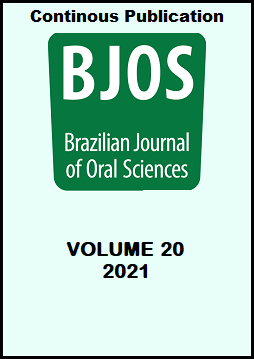Abstract
Aim: This study aimed to compare the microbiological potential and gustatory perception of essential oils (EO) mouthrinses containing and not containing alcohol. Methods: Twenty healthy adult volunteers rinsed with 10mL of the following test solutions: EO with alcohol, EO without alcohol, or a control solution (saline solution with mint essence). A washout period of at least seven days was adopted after a single-use protocol of the respective solution. All participants used all three tested substances. Antimicrobial potential was assessed by counting salivary total viable bacteria both before and after each rinse. Gustatory perception was evaluated using the Visual Analogue Scale (VAS). Multiple comparisons were performed with the Wilcoxon test, using Bonferroni correction. Results: Both EO solutions presented a higher antimicrobial potential in comparison to the control solution (p<0.017). However, no significant difference in antimicrobial potential was observed between EO containing or not containing alcohol (p=0.218). VAS of EO with alcohol (median: 2.7) was similar to control solution (median: 1.6) (p=0.287). A better gustatory perception was observed of the EO without alcohol (median 7.6) when compared to the control solution (p<0.0001). When EO groups were compared, EO without alcohol also demonstrated a significantly better gustatory perception (p=0.001). Conclusion: Mouthrinse containing EO without alcohol presented a better taste perception when compared to the EO with alcohol, but no difference was observed in the antimicrobial potential of both EO solutions after a single rinse protocol.
References
. Van der Weijden FA, Slot DE. Efficacy of homecare regimens for mechanical plaque removal in managing gingivitis a meta review. J Clin Periodontol. 2015 Apr;42 Suppl 16:S77-91. doi: 10.1111/jcpe.12359.
Haas AN, Pannuti CM, Andrade AK, Escobar EC, Almeida ER, Costa FO, et al. Mouthwashes for the control of supragingival biofilm and gingivitis in orthodontic patients: evidence-based recommendations for clinicians. Braz Oral Res. 2014 Jul 11;28(spe):1-8. doi: 10.1590/1807-3107bor-2014.vol28.0021.
de Andrade Meyer AC, de Mello Tera T, da Rocha JC, Jardini MA. Clinical and microbiological evaluation of the use of toothpaste containing 1% chlorhexidine and the influence of motivation on oral hygiene in patients with motor deficiency. Spec Care Dentist. 2010;30(4):140-5. doi: 10.1111/j.1754-4505.2010.00140.x.
Van Leeuwen MP, Slot DE, Van der Weijden GA. Essential oils compared to chlorhexidine with respect to plaque and parameters of gingival inflammation: a systematic review. J Periodontol. 2011 Feb;82(2):174-94. doi: 10.1902/jop.2010.100266.
Haas AN, Wagner TP, Muniz FWMG, Fiorini T, Cavagni J, Celeste RK. Essential oils-containing mouthwashes for gingivitis and plaque: Meta-analyses and meta-regression. J Dent. 2016 Dec;55:7-15. doi: 10.1016/j.jdent.2016.09.001.
Van Leeuwen MP, Slot DE, Van der Weijden GA. The effect of an essential-oils mouthrinse as compared to a vehicle solution on plaque and gingival inflammation: a systematic review and meta-analysis. Int J Dent Hyg. 2014 Aug;12(3):160-7. doi: 10.1111/idh.12069.
Cantarelli R, Ribas ME, Daudt FARL, Rosing CK. [Use profile of mouthwash used by patients at the UFRGS School of Dentistry]. Perionews. 2011;5:361-7. Portuguese.
Lynch MC, Cortelli SC, McGuire JA, Zhang J, Ricci-Nittel D, Mordas CJ, et al. The effects of essential oil mouthrinses with or without alcohol on plaque and gingivitis: a randomized controlled clinical study. BMC Oral Health. 2018 Jan 10;18(1):6. doi: 10.1186/s12903-017-0454-6.
Cantarelli R, Negrini TC, Muniz FW, Oballe HJ, Arthur RA, Rösing CK. Antimicrobial potential and gustatory perception of chlorhexidine gluconate mouthwashes with or without alcohol after a single rinse - a randomized controlled crossover clinical trial. Int J Dent Hyg. 2017 Nov;15(4):280-6. doi: 10.1111/idh.12255.
Cortelli JR, Cogo K, Aquino DR, Cortelli SC, Ricci-Nittel D, Zhang P, et al. Validation of the anti-bacteremic efficacy of an essential oil rinse in a Brazilian population: a cross-over study. Braz Oral Res. 2012 Sep-Oct;26(5):478-84. doi: 10.1590/s1806-83242012005000021.
Erriu M, Pili FM, Tuveri E, Pigliacampo D, Scano A, Montaldo C, et al. Oil Essential mouthwashes antibacterial activity against aggregatibacter actinomycetemcomitans: a comparison between antibiofilm and antiplanktonic effects. Int J Dent. 2013;2013:164267. doi: 10.1155/2013/16426.
Ajay Rao HT, Bhat SS, Hegde S, Jhamb V. Efficacy of garlic extract and chlorhexidine mouthwash in reduction of oral salivary microorganisms, an in vitro study. Anc Sci Life. 2014;34(2):85-8. doi: 10.4103/0257-7941.153465.
Ros-Llor I, Lopez-Jornet P. Cytogenetic analysis of oral mucosa cells, induced by chlorhexidine, essential oils in ethanolic solution and triclosan mouthwashes. Environ Res. 2014 Jul;132:140-5. doi: 10.1016/j.envres.2014.03.032.
Gunsolley JC. A meta-analysis of six-month studies of antiplaque and antigingivitis agents. J Am Dent Assoc. 2006 Dec;137(12):1649-57. doi: 10.14219/jada.archive.2006.0110.
Stoeken JE, Paraskevas S, van der Weijden GA. The long-term effect of a mouthrinse containing essential oils on dental plaque and gingivitis: a systematic review. J Periodontol. 2007 Jul;78(7):1218-28. doi: 10.1902/jop.2007.060269.
Sissons CH, Wong L, Cutress TW. Inhibition by ethanol of the growth of biofilm and dispersed microcosm dental plaques. Arch Oral Biol. 1996 Jan;41(1):27-34. doi: 10.1016/0003-9969(95)00103-4.
Marchetti E, Tecco S, Caterini E, Casalena F, Quinzi V, Mattei A , et al. Alcohol-free essential oils containing mouthrinse efficacy on three-day supragingival plaque regrowth: a randomized crossover clinical trial. Trials. 2017 Mar 31;18(1):154. doi: 10.1186/s13063-017-1901-z.
Simón-Soro A, Tomás I, Cabrera-Rubio R, Catalan MD, Nyvad B, Mira A. Microbial geography of the oral cavity. J Dent Res. 2013 Jul;92(7):616-21. doi: 10.1177/0022034513488119.
Miller MD, Ferris DG. Measurement of subjective phenomena in primary care research: the Visual Analogue Scale. Fam Pract Res J. 1993;13(1):15-24.
Kimberlin CL, Winterstein AG. Validity and reliability of measurement instruments used in research. Am J Health Syst Pharm. 2008 Dec;65(23):2276-84. doi: 10.2146/ajhp070364.
Sennhenn-Kirchner S, Wolff N, Klaue S, Mergeryan H, Borg-von Zepelin M. Decontamination efficacy of antiseptic agents on in vivo grown biofilms on rough titanium surfaces. Quintessence Int. 2009;40(10):e80-8.
Marchetti E, Casalena F, Capestro A, et al. Efficacy of two mouthwashes on 3-day supragingival plaque regrowth: a randomized crossover clinical trial. Int J Dent Hyg. 2017 Feb;15(1):73-80. doi: 10.1111/idh.12185.
Kim KJ, Komabayashi T, Moon SE, Goo KM, Okada M, Kawamura M. Oral health attitudes/behavior and gingival self-care level of Korean dental hygiene students. J Oral Sci. 2001 Mar;43(1):49-53. doi: 10.2334/josnusd.43.49.

This work is licensed under a Creative Commons Attribution 4.0 International License.
Copyright (c) 2021 Brazilian Journal of Oral Sciences


